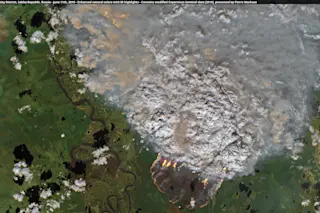I started writing this post last week after seeing the stunning satellite image above showing a blazing Siberian wildfire.
When I returned to finish the post today, I learned from a story in the Siberian Times that wildfires in this part of Russia’s Sakha Republic are now threatening a spectacular landscape feature known among locals as the “mouth of hell.”
They regard it as a doorway to the underworld.
Called the Batagaika Crater, it’s actually a giant gash in the local permafrost more than a half mile long and nearly 300 feet deep — and it has been growing, thanks to warming temperatures. If flames should reach it, the ground around it could be destabilized, potentially causing the mouth of hell to gape even wider.
More about that in a minute. But first, some details about the image of the wildfire itself.
It was created by blogger and remote sensing ...














